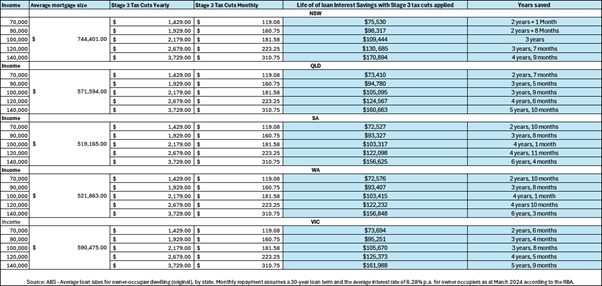

With the new financial year fast approaching, 13.6 million Australians are set to reap the benefits of the Stage 3 tax cuts.
While the average tax cut will be $1,888 per year, according to the government, homebuyers are set to receive a boost in borrowing power while homeowners could shave years of their mortgage.
But while cuts will put more money back into Australians’ pockets, not everyone is convinced it will translate into more demand in the property market.
“In my opinion this reprieve will be used in other areas,” said Ben Magnus (pictured above left), head of Empower Wealth Mortgage Advisory, which won the prestigious Liberty Australian Brokerage of the Year at the 2023 Australian Mortgage Awards in October.
“Electricity bills, retail shopping, insurances, petrol – this is where we have seen significant increases over the last 24 months.”
How the Stage 3 tax cuts will increase borrowing capacity
The Stage 3 tax cuts, which were changed recently by the Labor government, reduce the 32.5% tax bracket down to 30% and increase the 37% threshold from $120,000 to $135,000.
Additionally, the 45% threshold is being increased from $180,000 to $190,000, and the lowest tax bracket drops to 16%, from the current rate of 19%, for those earning between $18,000 to $45,000.
Mortgage aggregator and broker network Aussie recently crunched the numbers on a range of scenarios for potential purchasers on what impact the imminent stage three tax cuts will have for those trying to maximise their borrowing capacity when seeking out a home loan.
One such scenario explored by Aussie highlights that single Australians with no dependents earning $120,000 per year in FY24, who could borrow a maximum $615,135.18, will increase their borrowing capacity in FY25 by $27,061.93 on a mortgage based on a 6.28% interest rate to $642,197.44.
Here’s another example: A married couple with two dependents earning a combined taxable income of $280,000 will increase their borrowing capacity by $75,345.89 on a mortgage with a 6.28% interest rate in FY25. This is a 5.64% increase on their previous maximum borrowing amount of $1,334,871.22.
Aussie chief operating officer Sebastian Watkins (pictured above right), said the Stage 3 tax cuts can have some serious implications for those who are just outside their ideal borrowing capacity.
“Through our extensive broker network, we have been receiving feedback that many potential purchasers are just coming short of the desired amount they need to purchase their dream home especially as the price of property increases quicker than their ability to save or their wages to grow,” said Watkins.
“These borrowers evidently have two choices; look elsewhere for something cheaper and most likely less desirable to them or continue trying to save as much as they can whilst hoping their incomes grow at a higher rate than property prices.
“These tax cuts will mean there is a cohort of purchasers, who come July 1, will increase their borrowing capacity as their net income will grow and they will have more optionality when seeking finance for a home,” Watkins said.

How the Stage 3 tax cuts could shave years off the average home loan
For those who are still outside their desired borrowing capacity even with the tax cuts, Watkins said the need to remain focused on the end homeownership goal.
“Even if the tax cuts don’t automatically bump you up enough in terms of borrowing capacity, the additional income can be funnelled straight into extra savings for your deposit,” Watkins said.
“Ultimately the healthier your deposit the less you need to borrow, so this is really a win-win situation for those ready to enter the market.”
Homeowners who put their entire Stage 3 tax cut savings on their mortgage could also shave two to six years off the life of their loan, saving thousands, according to the Aussie research.
Those earning $70,000 and who put their full monthly savings of $1429 on their loan could reduce repayments by two to three years and pocket up to $75,530 in interest payments over the entirety of the debt.
For someone on double that wage, savings climb to as much as $171,000 and borrowers could unchain themself from their bank six years early.
How the Stage 3 tax cuts could help mortgage prisoners
While Magnus agreed that the tax cuts would increase borrowing capacity, he said it’s unlikely to be felt until the third quarter of 2024 – if at all.
“To really ignite the lending landscape we need to see a reduction in the cash rate (and passed on in full by the banks) in order to lift the property buying and refinancing market,” Magnus said.
Instead, Magnus recommends that any additional money should be spent where the most pressure is being felt.
“Can you continue to pay your health insurance, licences, rego and other bills? If not, then use the tax cut towards that. Or will this extra income allow you to clear some residual debt incurred over the past 18 months? If so, then do this, would be our advice,” said Magnus.
“Our position remains that clients need to ensure they manage their money and budget appropriately. Live within their means, don’t overextend yourself and build a stable savings buffer for tough times.”
However, Magnus said that, eventually, the cuts could free those stuck in mortgage prison.
While most have already transitioned onto higher rates, a significant mortgage cliff still looms for 27% of borrowers, who are set to shift from fixed-rate mortgages to higher variable rates within the next year, according to research conducted by Finder in May.
With lenders still assessing borrowers at 3% above the market, some homeowners could struggle to refinance with a different lender.
“More options will become available should they now be able to evidence a better income position, though again this won’t be seen until two or three months into the new financial year,” said Magnus. He said there may be more demand for property – just not in the immediate future.
“Internally, we also ensure our clients speak with their accountant on the best tax effective practice to ensure our clients can capitalise on these cuts.”
